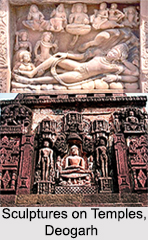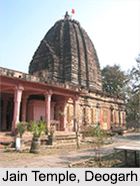![]() Deogarh is a village situated in the present Lalitpur district of the Indian state of Uttar Pradesh. It is a site of immense epigraphic and archaeological importance. The village has gloriously earned its place in the chronicles of history, relating to the Gupta Dynasty, the Gurjara Pratiharas, the Gonds, the Muslims, the Marathas and the British.
Deogarh is a village situated in the present Lalitpur district of the Indian state of Uttar Pradesh. It is a site of immense epigraphic and archaeological importance. The village has gloriously earned its place in the chronicles of history, relating to the Gupta Dynasty, the Gurjara Pratiharas, the Gonds, the Muslims, the Marathas and the British.
Deogarh is archaeologically and religiously significant for the monuments built by the Guptas and the established monuments of Hindu and Jain origins in and outside the fort atop the hill in the village. These monuments are protected by the Department of Archaeology of the Archaeological Survey of India (ASI).
 Etymology of Deogarh
Etymology of Deogarh
The name "Deogarh" is the concoction of two Sanskrit words, namely "Deo" referring to God and "garh" meaning fort. The name thus signifies "Fort of the Gods" literally.
Location of Deogarh
Deogarh village is situated along the right bank of Betwa River, at the point where it joins the reservoir formed by the Rajghat Dam. It is at the western end of the Lalitpur hills, 23 kilometres (14 miles) south-east of the Lalitpur town in the district and 123 kilometres (76 miles) south of the divisional administrative centre at Jhansi.
Demographics of Deogarh
As per the Census India 2011 report, the total population residing in the Deogarh village is 783, with a total of 152 households. The sex distribution of the population is 406 males and 377 females. The population of children between 0 to 6 years of age is 161. The literacy rate was recorded at approximately 41 per cent. Hindi and Bundeli are the main languages spoken here.
History of Deogarh
The earliest traces of history in Deogarh date back to the Gupta period between the 4th and the 6th centuries, which is known as the “golden period†of Indian history. This was also the time when Brahminical, Buddhist and Jain activities flourished in Northern India. It was during this age of the Guptas when the most famous and frequented temple of Deogarh was established, the Dashavatara Temple dedicated to Lord Vishnu. The Gupta period was followed by the Jain period between the 8th and the 17th centuries, where innumerable temples have been traced.
 Tourism in Deogarh
Tourism in Deogarh
The monuments of the Deogarh village are the prominent places of interest. For centuries, Deogarh has been famous as a temple town and attracts lots of tourists who look out for unconventional places.
Belonging to the 6th century, the Dashavatara Temple is the earliest known Panchayatana temple of North India. The sculptural art evolved immensely in this era, and this is well exemplified by the figurine sculptures which adorn the temples and their architecture of the time.
The village is also famous for its Jain temples, which number to as many as 31 and their panels vividly depict scenes from the Jain Mythology, votive pillars, votive tablets and Jain Tirthankara images, sculpted on all sides.
There are ghats that are of archaeological significance. The three "ghats" provide approach to the Betwa River edge from the fort - the Nahar Ghat, the Rajghat and the ghat with the Siddha-ki-Gufa.
Visiting Information to Deogarh
Deogarh is well connected by buses to all important centres in the region. The nearest airports are the Khajuraho Airport in the Chhatarpur District of Madhya Pradesh and Gwalior Airport in Madhya Pradesh, distanced 220 kilometres and 255 kilometres respectively. The nearest railway station is Jakhalaun Station, 13 kilometres from Deogarh, whereas Lalitpur is the most convenient railhead, 30 kilometres from Deogarh.



















